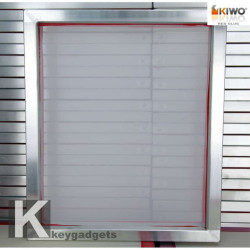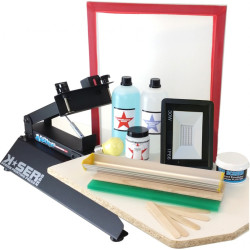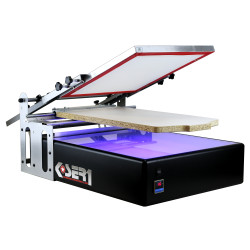 Screen Printing T-Shirts: The Ultimate Guide to Professional and Durable Prints
Screen Printing T-Shirts: The Ultimate Guide to Professional and Durable Prints
Screen printing on t-shirts is a textile printing technique that has stood the test of time and remains a cornerstone of the industry. Whether you're a professional printer, a fashion designer, or a DIY enthusiast, this comprehensive guide will help you master all aspects of screen printing t-shirts. From screen preparation to ink selection and the best machines on the market, you'll discover everything you need to achieve high-quality prints.
Table of Contents
- What is screen printing on t-shirts?
- The benefits of screen printing for t-shirts
- Key steps in textile screen printing
- Manual vs automatic screen printing: Which one to choose?
- Different types of screen printing inks
- How to choose the right screen printing equipment?
- Comparison of the best screen printing machines
- Essential accessories for screen printing
- Tips for perfect prints
- FAQ about screen printing t-shirts
- Conclusion: Key takeaways
What is screen printing on t-shirts?
Screen printing is a printing method that uses screens (or stencils) to transfer ink onto a textile surface, such as a t-shirt. This technique, used for decades, is renowned for its precision, durability, and ability to reproduce complex designs and vibrant colors.
The process begins with creating a screen, which is coated with a photosensitive emulsion. A positive film of the design is then exposed to light to transfer the pattern onto the screen. Once the screen is ready, ink is applied through it using a squeegee, creating a sharp and durable print.
The benefits of screen printing for t-shirts
- Exceptional durability: Screen prints can withstand numerous washes without fading or peeling.
- Versatility: Suitable for a wide variety of fabrics, colors, and designs, screen printing is ideal for both small and large volumes.
- Professional quality: The finishes are crisp, precise, and suitable for complex designs, even on dark fabrics.
- Cost-effectiveness: For large runs, screen printing is one of the most economical printing methods.
- Customization: Perfect for creating unique designs, whether for events, businesses, or fashion collections.
Key steps in textile screen printing
Screen printing on t-shirts follows a well-defined process that requires precision and attention to detail:
- Design creation: Create or import your design using graphic design software.
- Screen preparation: Apply a photosensitive emulsion to the screen and expose it to light with a positive film of the design.
- Exposure: Use an exposure unit to fix the design onto the screen.
- Printing: Place the t-shirt on the press and apply ink through the screen using a squeegee.
- Curing: Pass the t-shirt through a drying tunnel to set the ink permanently.
Manual vs automatic screen printing: Which one to choose?
Manual screen printing
- Ideal for small runs, beginners, and custom projects.
- Affordable and easy-to-use equipment.
- Offers great flexibility in customization.
Automatic screen printing
- Perfect for large runs and professionals.
- Offers superior precision and speed.
- Reduces errors and increases productivity.
For versatile projects, a semi-automatic screen printing press is an excellent compromise. Brands like Tiflex and Serigraphie-Boutique offer models tailored to various needs.
Different types of screen printing inks
Choosing the right ink is crucial for achieving quality results. Here are the most common options:
- Plastisol ink: The most widely used, it offers vibrant and opaque colors. Ideal for dark fabrics.
- Water-based ink: More eco-friendly, it provides a soft and natural feel to the fabric. Perfect for lightweight designs.
- Discharge ink: Used to create a washed-out effect on dark fabrics. It removes the fabric's dye for a vintage look.
- Silicone ink: Ideal for stretchy fabrics like sportswear.
How to choose the right screen printing equipment?
For professional results, consider the following:
- Type of press: Manual for small runs, semi-automatic or automatic for large volumes.
- Number of colors: Choose a press that suits the complexity of your designs.
- Screen quality: Opt for aluminum screens for better durability.
- Accessories: Squeegee, exposure unit, drying tunnel, etc.
Comparison of the best screen printing machines
| Model | Features | Ideal use |
|---|---|---|
| Manual 1-color press | Ideal for small workshops and beginners. | Small runs and simple designs. |
| Semi-automatic 6-color press | Versatile and suitable for complex designs. | Professional workshops and medium runs. |
| Automatic 8-color press | High speed and precision for large runs. | Industrial production. |
Essential accessories for screen printing
To achieve successful prints, here are the must-have accessories:
- Screen printing screens: Aluminum or wooden frames, depending on your needs.
- Squeegee: For applying ink evenly.
- Exposure unit: For precise screen preparation.
- Drying tunnel: To cure the ink for long-lasting results.
- Specialized inks: Plastisol, water-based, discharge, etc.
Tips for perfect prints
- Prepare your screens well: Ensure the emulsion is even and properly exposed.
- Choose the right ink: Match it to the fabric type and desired effect.
- Control the pressure: Even pressure ensures a clean print.
- Use a drying tunnel: To set the ink permanently.
- Test your prints: Run trials before starting a large batch.
FAQ about screen printing t-shirts
Q1: How many washes can a screen-printed t-shirt withstand?
A: A well-made print can endure over 50 washes without fading.
Q2: Can I do screen printing at home?
A: Yes, with a manual press and basic equipment, it's possible.
Q3: What’s the difference between screen printing and digital printing?
A: Screen printing is more durable and suited for large volumes, while digital printing is ideal for small runs and complex designs.
Conclusion: Key takeaways
- Choose the right technique: Manual for small runs, automatic for large volumes.
- Invest in quality equipment: Press, screens, and inks tailored to your needs.
- Opt for professional inks: Plastisol, water-based, or discharge, depending on the desired result.
- Follow best practices: Screen preparation, even pressure, and proper curing.
- Customize with creativity: Screen printing offers endless possibilities for unique designs.






